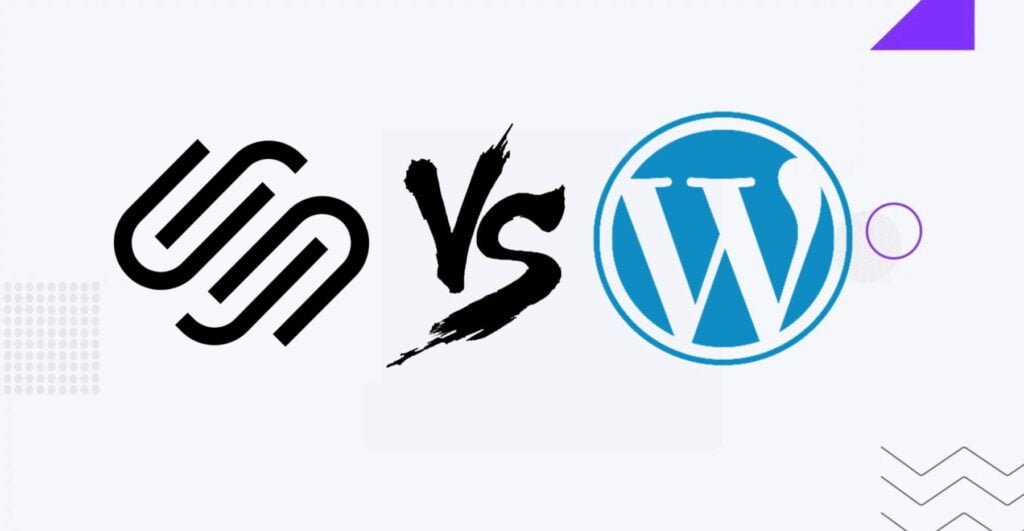Squarespace VS WordPress For Ecommerce
Table of Contents

Choosing the right ecommerce platform is crucial for the success of your online business. This decision affects how your website looks and performs, how easy it is to manage, and how well it can scale as your business grows. WordPress and Squarespace stand out as the industry leaders of many options available, often distinguished by their functionality. More importantly, both platforms are used to set up online stores. In this post, we’ll compare Squarespace vs WordPress for ecommerce.
We will explore the ease of use, design and customization options, ecommerce features, SEO and marketing tools, pricing, performance and security, customer support, and the pros and cons of each platform. By the end of our Squarespace vs WordPress for ecommerce comparison, you will clearly understand which platform better suits your ecommerce needs, highlighting why WordPress, especially its WooCommerce plugin, might be the superior choice for many businesses.
Overview of Squarespace and WordPress
To make an informed decision between Squarespace vs WordPress, it is essential to understand their histories, the services they offer, and the audiences they cater to. Let’s review both platforms, highlighting their origins and key features.
Squarespace

Squarespace was founded in 2003 by Anthony Casalena. What began as a humble project in Casalena’s dorm room has grown into one of the most well-known website-building platforms in the world. Initially designed to provide a straightforward and stylish way for individuals and small businesses to create websites, Squarespace has continually evolved to offer more comprehensive services, including ecommerce capabilities.
Squarespace is an all-in-one platform that provides everything needed to create a professional website. Its core services include website building, hosting, domain registration, and integrated ecommerce tools. Squarespace is renowned for its beautiful, professionally designed templates, which cater to various industries, from portfolios and blogs to online stores and business websites.
The platform is top-rated among small business owners, artists, photographers, and entrepreneurs who value aesthetics and simplicity. Its user-friendly interface and drag-and-drop editor make it accessible for users with little technical expertise. Squarespace’s built-in ecommerce features are designed to help users quickly set up and manage online stores, making it an appealing choice for those who want an attractive and functional website without delving into complex customization.
WordPress

WordPress was also launched in 2003, and Matt Mullenweg and Mike Little created it as a fork of a project called b2/cafelog. Since then, it has grown into the most widely used content management system (CMS) in the world, powering over 43% of all websites on the internet. WordPress is open-source software, which means it is free to use, and a large and active community drives its development.
WordPress comes in two versions. What is the difference between WordPress.com and WordPress.org?
- WordPress.com is a hosted service operated by Automattic, a company founded by Mullenweg (who founded WordPress). It provides a simplified way to create and manage a WordPress site without worrying about hosting and technical details. While it offers a free tier, premium plans are available with additional features and customization options.
- WordPress.org is the self-hosted version, which requires users to obtain their hosting and domain. This version provides WordPress’s full power and flexibility, allowing users to install custom themes and plugins, modify the code, and fully control their website.
WordPress.org offers unparalleled flexibility and customization options, making it suitable for many websites, from simple blogs and personal sites to complex business portals and ecommerce stores. Its extensive plugin ecosystem, with over 59,000 free plugins available, allows users to add virtually any functionality to their sites, from SEO tools and social media integrations to advanced ecommerce capabilities through plugins like WooCommerce.
The platform is favored by developers, large businesses, and users who need extensive customization and scalability. Despite its steeper learning curve compared to Squarespace, WordPress is also accessible to non-technical users, especially with the help of WordPress’s best themes and plugins. The active community provides extensive documentation, tutorials, and support, making it easier for newcomers to get started.
Ease of Use
Ease of use is a critical consideration when comparing Squarespace vs WordPress for ecommerce. A user-friendly interface and a simple setup process can significantly impact your ability to launch and manage your online store efficiently. We will compare the user interface and ease of setting up an ecommerce site on Squarespace and WordPress, as well as discuss the learning curve associated with each platform.
Squarespace User Interface and Setup
Squarespace is designed with simplicity and user-friendliness, making it an excellent choice for users without technical expertise. The platform offers a streamlined setup process and an intuitive, drag-and-drop interface.
- Sign Up and Choose a Template: The first step is to create an account and select a template from Squarespace’s extensive collection. These templates are professionally designed and fully responsive, catering to various websites, including ecommerce.
- Customize the Template: Squarespace’s drag-and-drop editor allows users to customize their chosen template easily. You can add and arrange text, images, videos, and product listings without coding skills. The editor is highly visual, making it straightforward to see changes in real-time.
- Set Up Ecommerce Features: Squarespace provides built-in ecommerce tools, making it simple to add products, manage inventory, set up payment gateways, and configure shipping options. Users can access these features directly from the main dashboard, centralizing all website management tasks.
- Launch the Site: Users can preview their site and make final adjustments before launching once everything is set up. Squarespace’s user-friendly interface ensures that even beginners can go live with their site quickly and confidently.
The learning curve for Squarespace is relatively shallow. The platform is designed to be intuitive, focusing on ease of use. Most users can set up their ecommerce site with minimal effort, even if they have no prior web design or development experience. Squarespace also provides comprehensive support resources, including a detailed help center, step-by-step tutorials, and responsive customer support to assist users in navigating the platform and resolving any issues.
WordPress User Interface and Setup
WordPress, especially the self-hosted version (WordPress.org), offers a more complex but highly customizable setup process. Setting up an ecommerce site on WordPress requires more technical know-how than Squarespace.
- Choose a Hosting Provider and Domain: Users must select a hosting provider and register a domain name. Many hosting providers offer one-click WordPress installation, simplifying the initial setup process.
- Install WordPress: After setting up hosting, users need to install WordPress. This step can be straightforward with managed WordPress hosting services or one-click installation options provided by many hosting companies.
- Select and Install a Theme: WordPress offers thousands of free and premium themes, allowing users to choose one that fits their ecommerce needs. Themes can be installed directly from the WordPress dashboard, and many come with built-in customization options.
- Install Ecommerce Plugins: To add ecommerce functionality, users typically install the WooCommerce plugin, a comprehensive and free ecommerce solution for WordPress. Additional plugins for specific features such as SEO, marketing automation, or enhanced security may be needed.
- Customize the Site: WordPress offers extensive customization options through themes, plugins, and custom code. Users can modify their site’s appearance and functionality to a great extent, providing flexibility that is unmatched by many other platforms.
- Set Up Ecommerce Features: WooCommerce guides users through adding products, managing inventory, configuring payment gateways, and setting up shipping options. This plugin integrates seamlessly with WordPress and offers a powerful set of ecommerce tools.
- Launch the Site: After customization and setup, users can preview their site and make any necessary adjustments before launching it. WordPress’s flexibility allows for extensive pre-launch testing and optimization.
When comparing Squarespace vs. WordPress for ecommerce, the learning curve is steeper for WordPress. The initial setup process requires more steps, including choosing a hosting provider, installing WordPress, and configuring plugins. Additionally, users must familiarize themselves with the WordPress dashboard, which, while powerful, can be overwhelming for beginners. However, once users become accustomed to the platform, WordPress offers unparalleled flexibility and control over the website.
WordPress’s extensive community support, including forums, tutorials, and documentation, is a valuable resource for users. Numerous online courses and guides are also available to help users learn how to use WordPress. For those willing to invest the time to learn, WordPress offers significant rewards in terms of customization and scalability.
Design and Customization
Design and customization capabilities are essential when choosing an ecommerce platform. The ability to create a visually appealing and unique online store can significantly impact user experience and, ultimately, sales. Let’s compare Squarespace and WordPress’s design and customization options, highlighting their strengths and limitations.
Squarespace Templates and Design Flexibility

Squarespace is known for its high-quality, professionally designed templates. The platform offers various templates tailored for various websites, including ecommerce. These fully responsive templates ensure your site looks great on all devices, from desktops to smartphones.
- Template Selection: Squarespace provides a curated collection of aesthetically pleasing and functional templates. Each template adheres to modern web design standards, ensuring a professional appearance.
- Customization Options: Squarespace’s drag-and-drop editor allows users to customize their chosen template easily. Users can add and arrange text, images, videos, and product listings. The platform offers a variety of customization options, including font styles, color schemes, and layout adjustments. Additionally, Squarespace includes built-in tools for basic SEO and social media integration.
- Design Tools: Squarespace offers several design tools, such as Style Editor, which allows for easy modifications to the look and feel of your site. Users can tweak typography, spacing, and button styles without coding knowledge. The platform also provides a Cover Page Builder for creating beautiful landing pages and a Logo Maker for designing a custom logo.
While Squarespace excels in ease of use and design quality, it does have some limitations when it comes to customization:
- Template Constraints: Customization within Squarespace is often limited to the options provided by the chosen template. Although users can make significant visual changes, they are generally confined to the structure and layout predefined by the template.
- Advanced Customization: For advanced customization, such as altering the template’s core code or adding complex functionalities, users need knowledge of CSS, JavaScript, and sometimes JSON. While Squarespace allows custom code injection, it is less flexible than the full coding freedom available on other platforms like WordPress.
- Third-Party Integrations: Compared to WordPress, Squarespace offers a more limited selection of third-party integrations. Although it supports essential integrations, users looking for specific tools or niche functionalities might find Squarespace’s options somewhat restrictive.
WordPress Templates and Customization Options

WordPress is renowned for its extensive customization capabilities, driven by its vast selection of themes and plugins. Whether you use WordPress.com or the self-hosted WordPress.org, you have access to a wide array of design options.
- Theme Selection: WordPress offers thousands of free and premium themes through the WordPress Theme Directory and third-party marketplaces like ThemeForest. These themes range from simple and minimalist designs to complex and feature-rich templates tailored for ecommerce.
- Customization Options: WordPress themes have customization settings, which can be accessed through the WordPress Customizer. Users can modify various aspects of their site, including fonts, colors, layouts, and more. Premium themes often include advanced options and built-in page builders like Elementor or WPBakery, which provide drag-and-drop functionality for easy customization.
- Design Tools and Plugins: WordPress’s extensive plugin ecosystem further enhances its flexibility. Plugins like Elementor, Divi, and Beaver Builder offer powerful drag-and-drop design capabilities, allowing users to create custom layouts and designs without coding. Additionally, WooCommerce-specific themes and plugins provide tailored design options for ecommerce sites.
While WordPress offers unparalleled customization options, there are a few potential limitations to consider:
- Complexity for Beginners: The vast array of themes and plugins can overwhelm beginners. Selecting the right combination of tools and learning how to use them effectively can require significant time and effort.
- Theme and Plugin Compatibility: Not all themes and plugins are compatible. Users may encounter conflicts that require troubleshooting and technical know-how to resolve. Ensuring compatibility and maintaining updates can add to the complexity of managing a WordPress site.
- Quality Control: Since WordPress is an open-source platform with contributions from developers worldwide, the quality of themes and plugins can vary. Users must diligently select reputable sources to avoid poorly coded or unsupported products.
Ecommerce Features
Ecommerce features are crucial when choosing a platform for your online store.
Squarespace offers a comprehensive set of built-in ecommerce features that are easy to use and integrate seamlessly into the platform. It is ideal for users who want a straightforward, all-in-one solution with minimal setup.
WordPress, powered by WooCommerce, provides extensive flexibility and customization options, making it suitable for users who require advanced features and are willing to invest time in setting up and managing their store. Each platform has its strengths, and the best choice depends on your specific ecommerce needs and technical capabilities.
Let’s compare Squarespace’s built-in ecommerce capabilities with the extensive plugin-based options available on WordPress, particularly focusing on WooCommerce.
Squarespace Built-in Ecommerce Features
Squarespace offers robust built-in ecommerce tools designed to help users easily set up and manage their online stores. These features are integrated into the platform, providing a seamless experience for ecommerce businesses.
- Product Management: Squarespace allows users to add, organize, and manage products easily. Users can create product variants, such as different sizes or colors, and manage stock levels directly from the platform. The product management interface is intuitive, making it simple to keep track of inventory.
- Payment Gateways: Squarespace supports several major payment gateways, including Stripe and PayPal. Users can also accept credit card payments directly through the platform. The integration process is straightforward, ensuring customers have a smooth checkout experience.
- Shipping Options: Squarespace provides flexible shipping options, allowing users to set up flat rates, weight-based rates, and real-time shipping calculations through carriers like USPS, FedEx, and UPS. Users can also create custom shipping rules based on location or product type.
- Tax Management: Squarespace automatically calculates sales tax for orders based on the shipping address. Users can also manually configure tax rates if needed. The platform supports tax exemptions and provides options for customizing tax rules.
- Marketing Tools: Squarespace includes built-in marketing tools to help users promote their online stores. These tools include email marketing, social media integration, and promotional pop-ups. Squarespace offers basic SEO settings to optimize product listings and improve search engine visibility.
- Analytics and Reporting: The platform provides comprehensive analytics and reporting tools, allowing users to track sales, monitor traffic, and gain insights into customer behavior. This data helps users make informed decisions to improve their ecommerce performance.
WordPress Ecommerce Plugins
WordPress’s ecommerce capabilities are primarily driven by plugins, with WooCommerce being the most popular and comprehensive option. WooCommerce transforms a WordPress site into a fully functional ecommerce store with a wide range of features.
- WooCommerce Core Features: WooCommerce is a free plugin that provides essential ecommerce features, including product management, inventory control, payment gateways, and shipping options.
- Product Management: Users can add unlimited products, create variations, and manage inventory. The interface is user-friendly, and products can be organized using categories and tags.
- Payment Gateways: WooCommerce supports a variety of payment gateways out of the box, including PayPal and Stripe. Additional gateways can be integrated through plugins, providing flexibility for different payment methods.
- Shipping Options: The plugin offers flexible shipping settings, including flat rates, free shipping, and real-time shipping calculations. Users can also set up shipping zones and classes to customize shipping rules.
- Tax Management: WooCommerce provides robust tax management features, allowing users to configure tax rates based on location, product type, or customer class. Integrations with services like TaxJar can enable automated tax calculations.
- Marketing Tools: WooCommerce integrates with various marketing tools and plugins, enabling users to email campaigns, create discount codes, and optimize their store for search engines. Plugins like Mailchimp for WooCommerce and Yoast SEO extend these capabilities.
Is WordPress better than Squarespace in terms of flexibility? To a certain degree, yes. One of WooCommerce’s major advantages is its flexibility and customization options. Users can tailor their ecommerce store to meet specific needs through custom code, plugins, and themes. This level of customization is particularly beneficial for businesses with unique requirements or those looking to scale and expand their online presence.
SEO and Marketing Tools
SEO and marketing tools are critical for driving traffic and increasing sales for your ecommerce site. Below, we compare Squarespace and WordPress’s SEO capabilities and marketing tools, emphasizing their strengths and limitations.
Is Squarespace Good for SEO?
It is a solid choice for SEO purposes. Squarespace offers a range of built-in SEO tools designed to help users optimize their sites without needing extensive technical knowledge:
- SEO-Friendly Templates: Squarespace’s templates are optimized for search engines. They feature clean, efficient code that ensures fast loading times and mobile responsiveness.
- Built-In SEO Settings: Users can easily customize page titles, meta descriptions, and URL slugs. Squarespace also allows for alt text customization for images, which is crucial for SEO.
- Automatic Sitemaps: Squarespace automatically generates XML sitemaps, making it easier for search engines to index your site.
- Clean URLs: The platform creates clean, search-engine-friendly URLs that help improve SEO.
- Mobile Optimization: All Squarespace templates are responsive, ensuring a good user experience on mobile devices, which is essential for SEO rankings.
Squarespace integrates several marketing tools to help users promote their ecommerce sites:
- Email Campaigns: Squarespace offers an integrated email marketing solution, enabling users to create and send branded email campaigns directly from the platform.
- Social Media Integration: Users can connect their Squarespace site to social media accounts, facilitating easy sharing of content and products.
- Promotional Pop-Ups: The platform includes tools for creating promotional pop-ups and banners that capture visitor attention and drive conversions.
- Basic Analytics: Squarespace provides built-in analytics to track site performance, such as traffic sources, visitor behavior, and sales data.
WordPress SEO Capabilities
WordPress is renowned for its powerful SEO capabilities, mainly due to its extensive plugin ecosystem and customization options:
- SEO Plugins: WordPress offers numerous SEO plugins, with Yoast SEO and All in One SEO Pack being the most popular. These plugins provide comprehensive tools for optimizing page titles, meta descriptions, XML sitemaps, and more.
- Customizable URLs: WordPress allows users to create custom permalinks, enabling SEO-friendly URLs with relevant keywords.
- Content Optimization: Plugins like Yoast SEO offer real-time content analysis and suggestions to help users optimize their posts and pages for specific keywords.
- Image Optimization: Plugins such as Smush and ShortPixel help optimize images for faster loading times, which is beneficial for SEO.
- Mobile Optimization: Many WordPress themes are designed to be mobile-responsive, and plugins like WPtouch can enhance mobile optimization further.
WordPress offers a wide range of marketing tools through plugins and third-party integrations:
- Email Marketing: Plugins like Mailchimp for WordPress and MailPoet enable seamless integration with popular email marketing services, allowing users to create and manage email campaigns.
- Social Media Integration: WordPress plugins such as Social Warfare and Revive Old Posts automate social media sharing and scheduling.
- Advanced Analytics: Google Analytics plugins, like MonsterInsights, provide detailed insights into site performance, visitor behavior, and sales data.
- Promotional Tools: WordPress plugins offer advanced promotional features, including pop-ups, banners, and lead capture forms. Examples include OptinMonster and Thrive Leads.
Pricing
Squarespace offers a clear, straightforward pricing structure with all-inclusive plans that cover hosting, templates, and basic ecommerce features. While this simplifies budgeting, users may incur additional costs for custom development and advanced marketing tools. WordPress provides a more flexible and potentially cost-effective solution but requires users to manage hosting, themes, and plugins separately. This can lead to additional costs, particularly for premium themes, plugins, and custom development. Each platform has its strengths, and the best choice depends on your specific ecommerce needs and budget considerations.
Let’s compare Squarespace vs WordPress for ecommerce pricing plans, including themes, plugins, and hosting.
Squarespace offers several pricing tiers, each with different features and capabilities:
- Personal Plan: $16/month (billed annually) — includes basic website features but lacks ecommerce functionality.
- Business Plan: $23/month (billed annually) — adds basic ecommerce capabilities with a 3% transaction fee on sales.
- Basic Commerce Plan: $27/month (billed annually) — removes transaction fees and includes advanced ecommerce features such as customer accounts and checkout on your domain.
- Advanced Commerce Plan: $49/month (billed annually) — includes all the features of the Basic Commerce Plan plus advanced shipping, subscriptions, and abandoned cart recovery.
Additional Costs:
- Custom Development: Squarespace offers limited customization, so users might not need significant custom development. However, hiring a developer for advanced customizations can add to the cost.
- Premium Templates: Most templates are included in the subscription, but premium templates or custom design services can incur additional costs.
- Email Marketing: Squarespace Email Campaigns is an add-on service, with pricing starting at $5/month.
The cost of WordPress varies depending on the components you choose:
- Domain and Hosting: Costs can range from $3 to $30+ per month, depending on the hosting provider and plan. Managed WordPress hosting services, like the ones provided by IT Monks.
- Themes: Free themes are available, but premium themes can cost between $30 and $100, with one-time payments or yearly subscriptions.
- Plugins: Many plugins are free, but premium plugins, depending on functionality and licensing, can cost between $20 and $100 or more.
Additional Costs:
- Custom Development: WordPress offers extensive customization options, often requiring custom development. On average, hiring a developer starts at $50+ per hour.
- Security and Maintenance: Additional plugins for security and site maintenance, like Sucuri or VaultPress, can add to the cost.
- Ecommerce Plugins: WooCommerce is free, but extensions for additional features (e.g., payment gateway and shipping solutions) may have associated costs.
Performance and Security
Squarespace offers comprehensive and reliable customer support through its 24/7 email and live chat services, well-organized help center, and active community forums. This makes it ideal for users who prefer an all-in-one solution with hands-on support.
WordPress, on the other hand, offers a more varied support experience. The quality of support largely depends on the hosting provider and the specific themes and plugins used. However, WordPress benefits from a vast and active community, extensive documentation, and numerous third-party resources, providing users with a wealth of information and assistance options. WordPress is a strong choice for those who value flexibility and are willing to invest time learning and managing their platform.
Customer Support
Customer support is crucial for resolving issues promptly and maintaining a smooth ecommerce operation. Let’s compare Squarespace vs WordPress for ecommerce pros and cons, support options, including community support and available resources.
Squarespace Customer Support Options
- 24/7 Email Support: Squarespace provides round-the-clock email support, allowing users to submit tickets and receive assistance anytime.
- Live Chat: Live chat support is available during specific hours, providing real-time help for urgent issues.
- Help Center: Squarespace’s help center is comprehensive, offering guides, tutorials, and video resources to assist users in troubleshooting issues and learning about the platform.
- Webinars and Workshops: Squarespace conducts webinars and workshops to help users maximize the platform’s potential and learn new skills.
WordPress Customer Support Options
- Hosting Provider Support: Support quality varies depending on the hosting provider. Managed WordPress hosting services, like WP Engine or SiteGround, and offered 24/7 support, including live chat, phone support, and ticket-based assistance.
- Theme and Plugin Support: Premium themes and plugins often come with dedicated support from their developers, providing direct assistance for specific issues related to their products.
- Documentation and Tutorials: Extensive documentation and tutorials are available on the WordPress.org website and other educational platforms. These resources cover various topics, from basic setup to advanced customization.
Squarespace and WordPress offer robust support options but with some key differences.
Squarespace excels in providing direct, comprehensive support through its 24/7 email and live chat services. Its help center and community forum also provide valuable resources, making it ideal for users who prefer immediate assistance and a centralized support hub.
WordPress offers strong support options through managed hosting providers and plugin/theme developers, but it stands out for its vast user community and extensive third-party resources. This makes it a versatile choice for users who value flexibility and access to a wide range of knowledge and solutions.
Pros and Cons
Pros and Cons of Using Squarespace for Ecommerce
| Pros | Cons |
|---|---|
| User-Friendly Interface: Squarespace offers an intuitive drag-and-drop interface, making it easy for beginners to build and manage their ecommerce sites. | Limited Customization: Compared to WordPress, Squarespace has limited customization options, especially for advanced users who may require specific functionalities. |
| All-in-One Solution: Squarespace provides hosting, templates, and ecommerce features in one package, simplifying setup and management. | Transaction Fees: Lower-tier plans impose transaction fees on sales, which can impact profitability for smaller businesses. |
| Design and Templates: Squarespace offers professionally designed templates that are mobile-responsive and visually appealing, catering to various industries | Dependency on Squarespace: Users are tied to Squarespace’s ecosystem and may face limitations in integrating third-party services or scaling beyond basic ecommerce needs. |
Pros and Cons of Using WordPress for Ecommerce
| Pros | Cons |
|---|---|
| Flexibility and Customization: WordPress offers unparalleled flexibility with thousands of plugins and themes, allowing users to create highly customized ecommerce sites. | Learning Curve: WordPress has a steeper learning curve than Squarespace, requiring users to manage hosting, updates, and security. |
| Scalability: With the right hosting and plugins, WordPress can scale to meet the needs of small businesses and large enterprises. | Maintenance: Users are responsible for maintaining their WordPress site, including updates, backups, and security measures, which may require technical knowledge or additional resources. |
| SEO Capabilities: WordPress provides extensive SEO plugins and tools, empowering users to optimize their sites for search engines effectively. | Quality of Themes and Plugins: While WordPress offers a vast selection of themes and plugins, the quality can vary, and premium options may incur additional costs. |
Conclusion
In a nutshell, is WordPress better than Squarespace? Based on our Squarespace vs WordPress ecommerce comparison, you may notice that both platforms offer unique strengths. The best decision depends on your technical comfort level, customization requirements, and long-term goals for your ecommerce venture.
Choose Squarespace if you prioritize ease of use, streamlined setup, and comprehensive support. It’s ideal for users who prefer a straightforward, all-in-one solution with user-friendly tools and templates.
Consider using WordPress if you value flexibility, customization options, and scalability. It’s suitable for users willing to invest time in learning and managing their site, leveraging a vast ecosystem of plugins and themes for tailored ecommerce solutions.
Do you prefer using WordPress for ecommerce purposes? The expert team of IT Monks web designers and developers will build a custom website for your business to engage loyal customers, drive more sales, and be more noticeable in search results. Contact us to discuss the details of your project and start working on your ecommerce store!
Contact
Don't like forms?
Shoot us an email at [email protected]




